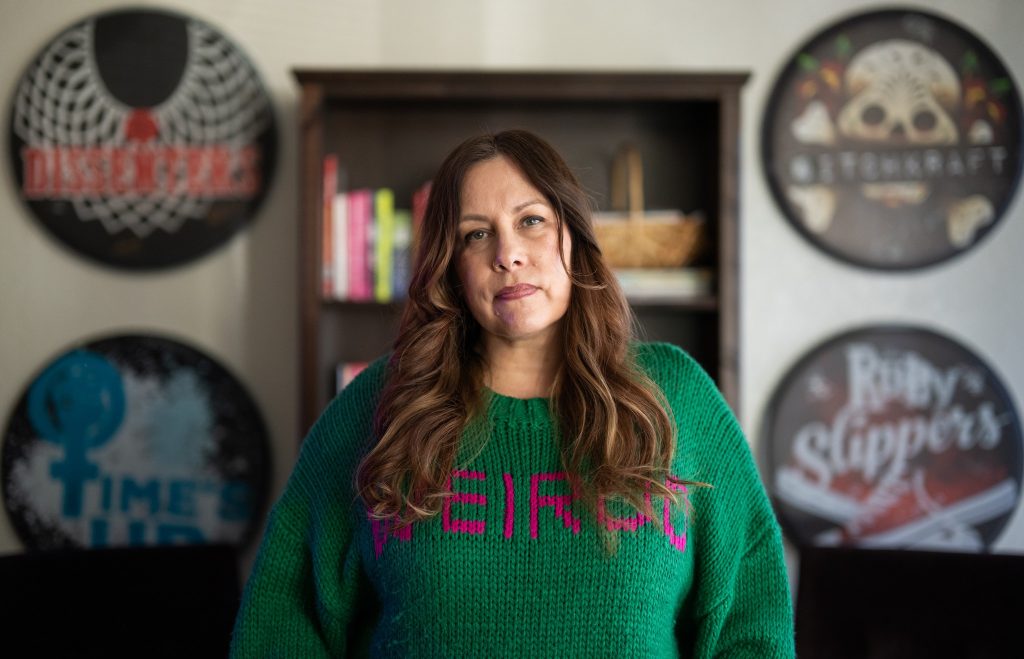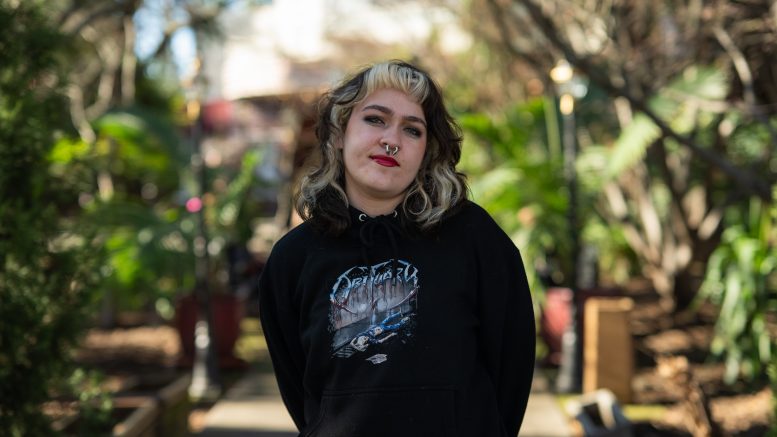By Rachel Leibrock
Ruby Copher was 15 the first time she played for a crowd. It was the summer of 2021 at Swabbies on the River, and she was there with a band put together during a weeklong stint in G.I.R.L.S. Rock Sacramento, a local nonprofit music organization.
Copher was excited for the chance, but also, perhaps, a little bit anxious. She’d been playing guitar for two years, but this would be her biggest show yet.
“It was nerve-wracking,” she says now. “But we’d spent all this time building community and there were all these people who’d come out. I felt like I was being taken care of and set up for success.”
Now 18, Copher remembers the experience as unique — not just because of the venue or the audience but because she had the chance to play to a crowd at all. Since COVID, she says, the number of places for under-21 folks to perform — and listen to — live music, has shrunk.
“I mostly play metal and punk, and that community is really tight and DIY so there are opportunities once you get to know people,” she says. “But with [other types of music] the chances to play live are harder to come by.”
Regardless of genre, some in the Sacramento region believe that the all-ages music scene has faded since its 2000s-era glory days, due in part to the pandemic. Others, however, argue that youth-friendly options abound with just as many venues as ever.
The true state of the all-ages scene, however, more likely exists somewhere in the middle.
‘It’s important to have third spaces’
True Love Coffeehouse. Capitol Garage. Shine Café. Luigi’s Pizza Parlor. In the early-to-mid 2000s these were just some of the downtown and Midtown Sacramento spots hosting regular all-ages shows. Although the choices grew scarcer past the grid, a scattering of churches and coffeeshops were also age inclusive.
Larisa Bryski, G.I.R.L.S. Rock Sacramento co-founder and executive director, remembers the era fondly.
“Back then there were a lot of all-ages spots and there was a lot of buzz around all those venues and a lot of kids wanting to play or see live music,” says Bryski, whose organization teaches girls how to play music. “Now, I don’t see any difference in the amount of young people who want that, but I just don’t see enough places for them to play.”
With G.I.R.L.S. Rock Sacramento, Bryski and her team create a safe space for youth to enjoy and create music but, she worries, where do they go when they’ve finished their stint?
There are some notable outlets: Harlow’s and its sister club, the upstairs Starlet Room, regularly hosts all-ages shows in Midtown, as does the Ace of Spades, several blocks over. Further afield, The Boardwalk in Orangevale and Goldfield Trading Post in Midtown and Roseville also put on all-ages shows.
These are bigger rooms, however, not the small to midsize rooms of the aughts where kids and teens could cut their musical teeth without the pressure of drawing a large crowd. In that category the choices are notably fewer: Café Colonial in South Sacramento, The Red Museum downtown, and a handful of other spots that occasionally present all-ages gigs.
“[Before], it seems like people were trying harder before with opportunities for bands and singer-songwriter situations for kids who just wanted to get up on stage for the first time,” Bryski says.
Now, she says, COVID and its ensuing lockdown accounts for at least one significant cause of the decrease in venues that regularly cater to an all-ages crowd. While nightclubs such as Harlow’s have the means to operate a bar during an all-ages show, smaller venues are likely to lose out on a sizable income stream through alcohol sales.
“[Post-pandemic] people were struggling in the local entertainment industry,” she says. “From a business standpoint, people [want] to focus on opportunities that are money-making and you’re not going to make as much money if you don’t have a bar.”
With or without booze, the music fan-to-musician pipeline is a two-way conduit.
When youth have the chance to take in live music, Bryski says, they build an appreciation for the art and, sometimes, an aspiration to create it themselves. Either way, that hunger for live music often lasts well into adulthood and helps to create the foundation for a robust arts and culture scene.
“Music, in an overarching way, builds community,” Bryski says. “I’ve seen firsthand how kids thrive when they’re with people who are like-minded.”
Copher, who still plays music in a handful of bands including her main project, Whoreified, agrees. While punk and metal bands often rely on house shows for gigs, the City of Sacramento and venue owners should work harder to create or support more prospects for young musicians and music fans of all genres.
Since the pandemic, she says, there are fewer so-called “third spaces”— places that are separate from home and work, such as cafes, where people can gather informally to hang out. Factor in an ever-increasing dependency on screens, she adds, and young people are less likely to go out, which in turn means they’re less likely to build tangible kinships.
“Sometimes it’s hard enough even for myself to go out when it’s so easy to just sit in bed on your phone and have relationships over text or social media,” she says. “That’s why it’s important to have those third spaces.
The rise and fall — and rise — of the all-ages scene

Longtime Sacramento music promoter Brian McKenna says the all-ages scene hasn’t really changed much in the 35 years he’s been booking shows. It’s always been a mix of venues that cater to a range of audiences, big and small. And because it’s a fickle business, spots open and close and prospects ebb and flow. Currently, he says, the landscape is vibrant.
“There are a good number of spots right now, probably as many as there ever were that I can remember,” he says.
McKenna started his career on his own in the 1980s before teaming up with another Sacramento booking mainstay, Jerry Perry, to form New View Music Productions in 1989. In 1994, he formed his own company, Abstract Entertainment. Whether it was at the El Dorado Saloons and Cattle Clubs of yesteryear or modern venues like Goldfield’s Trading Post or Harlow’s, McKenna says he’s always made a point to try to book all-ages events. And, just like back in the day, he adds, there’s still a healthy house scene offering occasional one-off gigs throughout the suburbs.
The main factor that’s changed, he says, is that city officials are actively trying to make the process easier for venue owners and bookers by simplifying permit processes and working with venues to navigate regulations.
“In years past it was more prohibitive to [book all-ages shows],” he says. “There was a lot of red tape and a café that held shows for 50 people had to go through the same processes as a venue hosting 400 people.”
Over at Café Colonial, booker Anna Gaitan says they’ve benefited from improved city efforts, including assistance with adhering to the rules for required security presences or health inspections for the kitchen. As the Colonial’s audiences have grown from an average of 20 people per show to upward of 60, it’s critical to be afforded reasonable flexibility.
“A little grace goes a long way,” she says.
Historically, she adds, the city hasn’t always supported the scene, particularly during economic downturns. Less money and support meant fewer safe spaces for teens.
It helps, she says, that the city has opened up funding grants to smaller venues, including those without bars.
“It wasn’t always on the table for [venues] that operate at a micro capacity,” she says. ‘“Now, we apply for everything even if it’s two years out. It helps us upgrade equipment or fix something that needs love.
Now, Gaitan, who is in a business partnership with Jim Cornett, owner and general manager for Harlow’s, sees Café Colonial as both that safe space and a bridge between house shows and bigger spots. On the Colonial’s stage, artists can get their first shot playing to a group before moving on to larger shows. It’s also a place for teenagers to nurture a love for live music, whether they’re watching or playing.
“This is a labor of love that provides accessibility to arts, music and cultural events for children, teens and young adults,” she says. “It can help them [appreciate] or flourish in something they may not have been exposed to otherwise.”
Like McKenna, Gaitan says that while there’s always room for more places that regularly accommodate an all-ages audience, particularly post-COVID, the scene is trending with an upward traction.
“The young musicians who are starting their bands right now, they are the foundation,” she says. “I’m excited for the future of all-ages music in Sacramento.”
This story was funded by the City of Sacramento’s Arts and Creative Economy Journalism Grant to Solving Sacramento. Following our journalism code of ethics and protocols, the city had no editorial influence over this story and no city official reviewed this story before it was published. Our partners include California Groundbreakers, Capital Public Radio, Outword, Russian America Media, Sacramento Business Journal, Sacramento News & Review, Sacramento Observer and Univision 19. Sign up for our “Sac Art Pulse” newsletter here.


Be the first to comment on "The role of ‘third spaces’ in keeping all-ages music alive in Sacramento"